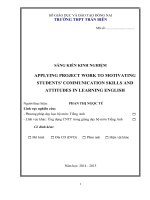( English project) Midautumn festival
Bạn đang xem bản rút gọn của tài liệu. Xem và tải ngay bản đầy đủ của tài liệu tại đây (63.31 KB, 2 trang )
Group 1
Mid-Autumn Festival
The Mid-Autumn Festival is a harvest festival celebrated by ethnic Chinese and Vietnamese people.
The festival is held on the 15th day of the 8th month of the lunar calendar with full moon at night,
corresponding to late September to early October of the Gregorian calendar with full moon at night.
The Mid-Autumn festival is named "Tết Trung Thu" in Vietnamese. It is also known as Children's
Festival because of the event's emphasis on children. In olden times, the Vietnamese believed that
children, being innocent and pure, had the closest connection to the sacred and natural world. Being
close to children was seen as a way to connect with animist spirits and deities.
Aside from the story of Chang'e (Vietnamese: Hằng Nga), there are two other popular folktales
associated with the festival. The first describes the legend of Cuội, whose wife accidentally urinated on
a sacred banyan tree. The tree began to float towards the moon, and Cuội, trying to pull it back down
to earth, floated to the moon with it, leaving him stranded there. Every year, during the Mid-Autumn
Festival, children light lanterns and participate in a procession to show Cuội the way back to Earth. The
other tale involves a carp who wanted to become a dragon, and as a result, worked hard throughout
the year until he was able to turn into a dragon.
Meanings of the festival (3)
•
Gathering, such as family and friends coming together, or harvesting crops for the festival. It's
said the moon is the brightest and roundest on this day which means family reunion.
•
Thanksgiving, to give thanks for the harvest, or for harmonious unions
•
Praying (asking for conceptual or material satisfaction), such as for babies, a spouse, beauty,
longevity, or for a good future
Traditions and myths surrounding the festival are formed around these three concepts, although
traditions have changed over time due to changes in technology, science, economy, culture, and
religion. It's about well being together.
The festival was a time to enjoy the successful reaping of rice and wheat with food offerings made in
honor of the moon. Today, it is still an occasion for outdoor reunions among friends and relatives to eat
mooncakes and watch the moon, a symbol of harmony and unity. The festival is celebrated with many
cultural or regional customs, among them.
There are many interesting activities, too. The first is making and sharing mooncakes is one of the
hallmark traditions of this festival. The sharing and eating of round mooncakes among family members
during the week of the festival signify the completeness and unity of families. In modern times,
however, making mooncakes at home has given way to the more popular custom of giving mooncakes
to family members, although the meaning of maintaining familial unity remains. The second is drinking
tea. Teacups were placed on tables, where the family pour tea and chat, waiting for the moment when
the full moon's reflection appeared. Otherwise, families in Vietnam can offer a tray (includs apples,
pears, peaches, grapes, pomegranates, melons, oranges, and pomelos) called “mâm ngũ quả”. This
activity is more popular than drinking tea in our country.
Cakes and fruits are not only consumed, but elaborately prepared as food displays. For example,
glutinous rice flour and rice paste are molded into familiar animals. Pomelo sections can be fashioned
into unicorns, rabbits, or dogs. Villagers of Xuân La, just south of Hanoi, produce tò he, figurines made
from rice paste and colored with natural food dyes. Into the early decades of the twentieth century of
Vietnam, daughters of wealthy families would prepare elaborate centerpieces filled with treats for their
younger siblings. Well-dressed visitors could visit to observe the daughter's handiwork as an indication
of her capabilities as a wife in the future. Eventually the practice of arranging centerpieces became a
tradition not just limited to wealthy families.
One important event before and during the festival are lion dances. Dances are performed by both nonprofessional children's groups and trained professional groups. Lion dance groups perform on the
streets, going to houses asking for permission to perform for them. At the end f the evening, the most
exciting and interesting activity will take place. Children participate in parades in the dark under the full
moon with lanterns of various forms, shapes, and colors (the most popular is the traditional 5-pointed
star-shaped lantern). Traditionally, lanterns signified the wish for the sun's light and warmth to return
after winter. In addition to carrying lanterns, the children also wear masks, too.
I think this is a necessary, interesting & joyful festival because it makes children happier after a hardworking year. They can hang out & play with their friends, eat delicious food, join many outdoor
activities,... This festival also makes the families closer, too. What a meaningful festival!
NNA









